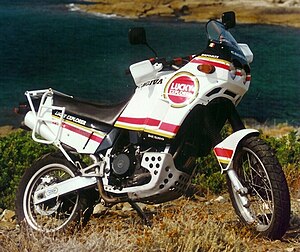Cagiva elephant 900
| Cagiva | |
|---|---|
 Cagiva 900 ie Lucky Explorer |
|
| Elephant 900 ie | |
| Manufacturer | Cagiva SpA, Schiranna, Lake Varese, Varese, Italy |
| Sales description | Elefant 900 ie Lucky Explorer (Type 1B) |
| Production period | 1991 to 1992 |
| class | motorcycle |
| design type | Enduro |
| Motor data | |
| air / oil-cooled two-cylinder four-stroke 90 degree Ducati L engine | |
| Displacement (cm³) | 904 |
| Power (kW / PS ) | 54/73 at 6500 rpm |
| Torque ( N m ) | 70 Nm at 5500 rpm |
| Top speed ( km / h) | 171 |
| transmission | Claw-shifted five / six-speed gearbox (ie / ac, ieGT) |
| drive | Chain drive |
| Brakes | Single disc brake with double-piston calipers at the front, disc brake with double-piston calipers at the rear |
| Wheelbase (mm) | 1,550 |
| Dimensions (L × W × H, mm): | 2,275 x 860 x 966.5 |
| Seat height (cm) | 84 |
| Empty weight (kg) | 225 |
| Previous model | Cagiva Azzalin Elephant 900 Paris Dakar |
| successor | Cagiva Elefant 900 ie GT |
The Cagiva Elefant 900 is a motorcycle model from the Italian motorcycle manufacturer Cagiva . The Enduro was designed to compete with the Honda XRV 750 Africa Twin , BMW R 100 GS and Yamaha XTZ 750 travel enduro bikes .
With the Elefant 650, Cagiva was the third manufacturer after BMW and Honda in 1985 to bring an enduro with a two-cylinder engine onto the market. The 650 cc Ducati V2 engine with a nominal 50 HP output and high-quality suspension elements from Öhlins and Marzocchi was used .
As part of the first facelift, the cubic capacity was increased to 750 cm³ and the originally unclad model was equipped with a small frame-mounted cladding.
Cagiva's participation in the Dakar Rally resulted in a model with a 904 cc displacement. After Edi Orioli won this rally in 1990 (3rd place Alessandro De Petri in a Cagiva Elefant), an attempt was made to achieve economic success with a new model in the "Lucky Explorer" design of the factory machines.
As a highlight, the new Elefant 900 ie Lucky Explorer ( Lucky Strike was a sponsor of the victorious Dakar team) was presented in 1991 . The machine had the design of the factory machines and was equipped with an electronic Magneti Marelli injection system, an Öhlins shock absorber and a Marzocchi fork in conjunction with a 19 "front wheel, which was unusual at the time. The high new price of around DM 18,500 (a Honda XRV 750 The Africa Twin cost 10,500 DM at the time), however, prevented its widespread use.Only 1,000 motorcycles were built, of which only a few are still in their original condition.
Since the motorcycle had an aggressive appearance, a "civil" looking model - the Elefant 900 ie GT - was brought onto the market after almost two years . In this u. a. The following adjustments were made for the mass market: 6-speed gearbox, stronger alternator, shorter spring travel for a lower seat height and a simple gray metallic paintwork.
The end point of the production of the Cagiva Elefant were the variants with a carburettor engine and 748 cm³ or 904 cm³, the chassis of which remained behind the original model due to less spring travel and the lack of high-quality components. The off-road qualities of these two models had taken a back seat.